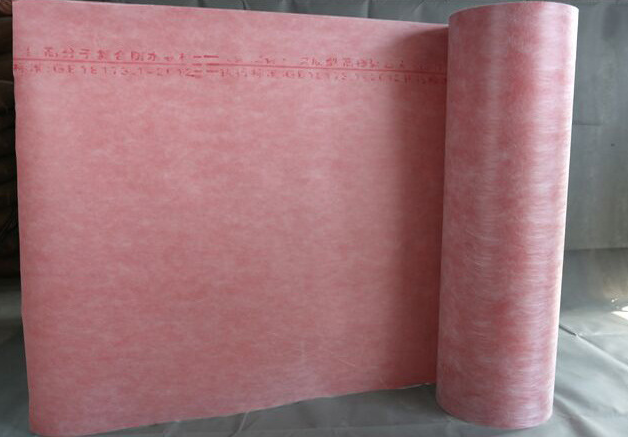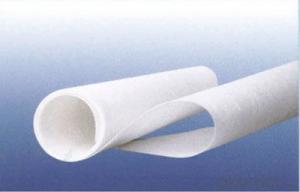Polyethylene Polypropylene Waterproofing Membrane
- Loading Port:
- China main port
- Payment Terms:
- TT OR LC
- Min Order Qty:
- 5000 g/m²
- Supply Capability:
- 100000 g/m²/month
OKorder Service Pledge
OKorder Financial Service
You Might Also Like
1.Structure of Polyethylene Waterproofing Membrane Description:
Polyethylene waterproofing membrane belongs to polymer waterproofing materials series.Besides completely with all the advantages of the synthesis of polymer coil, its most prominent characteristic is the surface mesh structure, making its have the use of their own unique performance, cement bonding.Due to that the high polymer compound coil can be directly in the process of solidification with cement material of adhesive, so can design in the structure of the cement materials directly. The surface is polypropylene non-woven fabrics, through with the composite core layer, solves the large polyethylene linear expansion coefficient and increases the roughness on the surface of the product.And also it improve the product friction coefficient and compound coil bonding problem is resolved, cement bonding realizing.
2.Main Features of the Polyethylene Waterproofing Membrane:
•Anti-aging, anti-oxidation, corrosion resistance
•Non-toxic,tasteless, no pullution
•Firm adhesion, no empty drum, no falling off
•Strong tensile strength, penetration resistance
•Convenient for construction in winter
3.Polyethylene Waterproofing Membrane Specification:
| Name | Thickness(mm) | Width(m) | Length(m) | Weight(g) |
| Polyethylene Waterproofing Membrane | 0.5mm-2mm | 1.0-1.2 | 500-1000m | 200-1200 |
4.Polyethylene Waterproofing Membrane Images:

- Q:Are there any specific building code requirements for waterproofing membranes?
- Waterproofing membranes are subject to specific building code requirements. These requirements vary depending on the jurisdiction, but most codes mandate that waterproofing membranes meet certain standards and specifications. The purpose of these requirements is to protect buildings from water damage and maintain the safety and integrity of the structure. Some typical building code requirements for waterproofing membranes include: 1. Material standards: The building code may stipulate the type of materials that are permissible for waterproofing membranes. This can include specifications for the membrane's type, such as liquid-applied or sheet membranes, as well as requirements for thickness and composition. 2. Installation standards: The building code may provide specific instructions and techniques for installing waterproofing membranes. This can include requirements for appropriate surface preparation, application procedures, and details concerning penetrations and transitions. 3. Testing and certification: Building codes may mandate that waterproofing membranes undergo certain tests and meet specific performance criteria. This can include tests for water penetration resistance, durability, and compatibility with other building materials. In some cases, the code may require certification from a recognized testing laboratory. 4. Code compliance documentation: Building codes often demand that waterproofing membranes be installed in accordance with approved plans and specifications. This means that contractors may need to submit documentation to demonstrate compliance with the code, such as product data sheets, manufacturer's installation instructions, and details of the proposed waterproofing system. It is crucial to consult the local building code or regulatory authority to ascertain the specific requirements for waterproofing membranes in a particular jurisdiction. Complying with these requirements is vital to ensure the proper functioning and longevity of the waterproofing system and to prevent issues like water intrusion, mold growth, and structural damage.
- Q:Can a waterproofing membrane be used on interior walls?
- Yes, a waterproofing membrane can be used on interior walls to prevent water infiltration and moisture damage.
- Q:Is a waterproofing membrane resistant to gasoline or other petroleum-based substances?
- Yes, a waterproofing membrane is generally resistant to gasoline and other petroleum-based substances.
- Q:Can a waterproofing membrane be used for a plaza deck?
- Yes, a waterproofing membrane can be used for a plaza deck. A plaza deck is a flat surface that is usually elevated and exposed to various weather conditions, such as rain, snow, and sunlight. Waterproofing membranes are designed to provide a barrier against water penetration and protect the underlying structure from moisture damage. They are commonly used in outdoor applications, including plaza decks, to prevent water infiltration into the building or structure below. By installing a waterproofing membrane on a plaza deck, it helps to ensure the longevity and durability of the deck, while also providing a safe and dry environment for pedestrians.
- Q:Are there any specific safety precautions to consider when installing a waterproofing membrane?
- When installing a waterproofing membrane, there are various safety precautions to consider. To begin with, it is crucial to ensure that the installation team uses all necessary personal protective equipment (PPE). This may incorporate gloves, safety glasses, and appropriate footwear to prevent injuries or exposure to dangerous substances. Moreover, it is essential to work in a well-ventilated area to avoid inhaling fumes or vapors emitted during the installation process. If working in a confined space, it is necessary to take proper measures to guarantee sufficient ventilation and use suitable respiratory protection if needed. Furthermore, it is vital to adhere to the manufacturer's instructions and guidelines for the specific waterproofing membrane being installed. This involves understanding any potential hazards linked with the product, such as flammability or toxicity, and taking necessary precautions to prevent accidents or exposure. Another safety consideration is to make sure that the installation area is appropriately prepared before commencing the process. This might entail clearing any debris, cleaning the surface, and addressing any potential hazards or obstacles that could pose a risk to the installation team. Lastly, it is important to have a designated safety plan in place, including emergency procedures and easily accessible first aid kits in case of accidents or injuries. Regular safety inspections and monitoring throughout the installation process are also recommended to promptly identify and address any potential safety risks. By adhering to these safety precautions, the installation of a waterproofing membrane can be carried out securely and effectively, minimizing the risk of accidents or injuries.
- Q:Can waterproofing membranes be used in basements?
- Yes, waterproofing membranes can be used in basements. Waterproofing membranes are specifically designed to provide a barrier against water penetration and are commonly used in basements to prevent moisture and water seepage. These membranes are typically made of materials such as rubber, bitumen, or polyethylene, and are applied to the basement walls and floors to create a waterproof seal. By preventing water from entering the basement, these membranes help to protect the foundation, walls, and interior spaces from water damage, mold, and other moisture-related issues. Additionally, waterproofing membranes can also be used in combination with other waterproofing techniques such as drainage systems and sump pumps to provide comprehensive protection against water infiltration in basements.
- Q:On the roof of the waterproofing membrane paving the direction of what are the requirements
- The direction of the web should be determined according to whether the slope of the roof and the roof is affected by vibration: when the slope of the roof is within 3%, the asphalt waterproofing membrane should be parallel to the roof; at 3% ~ 15%, the asphalt waterproofing membrane may Parallel or vertical roof paving; slope greater than 15% or by vibration of the roof, asphalt waterproofing membrane should be vertical roof paving, and polymer modified asphalt waterproof and synthetic polymer waterproofing membrane can be parallel or vertical roof paving; The upper and lower layers should not be piled with each other vertically.
- Q:Does a waterproofing membrane have any fire resistance properties?
- No, a waterproofing membrane typically does not have any fire resistance properties. The main purpose of a waterproofing membrane is to provide a barrier against water infiltration and protect the underlying structure from moisture damage. Fire resistance, on the other hand, refers to a material's ability to withstand fire or reduce the spread of flames. Fire resistance properties are typically found in specialized fireproofing materials or coatings, which are designed to prevent the spread of fire and protect the structure in case of a fire incident. It is important to consider both fire resistance and waterproofing requirements when selecting materials for construction projects, as they serve different purposes and may require separate measures to ensure safety.
- Q:Can a waterproofing membrane be used in conjunction with warranty or insurance policies?
- Typically, a waterproofing membrane can be used alongside warranty or insurance policies. Various waterproofing products and systems come with warranties that offer coverage for a specific duration, typically ranging from 5 to 20 years or even longer. These warranties often guarantee the effectiveness and durability of the waterproofing membrane, and may include provisions for repairs or replacements in the event of any failures or defects. Moreover, insurance policies may also provide coverage for damages caused by water leaks or flooding. By installing a waterproofing membrane, property owners can minimize the risk of water damage and potentially lower their insurance premiums. It is advisable to inquire with your insurance provider to determine if they offer any discounts or incentives for utilizing waterproofing systems. Nevertheless, it is crucial to note that the coverage provided by warranties and insurance policies may vary based on specific terms and conditions. It is recommended that you carefully review the details of the warranty or insurance policy and seek guidance from professionals to ensure that the waterproofing membrane aligns with the requirements and specifications outlined in these agreements.
- Q:How does a waterproofing membrane handle seismic movements?
- A waterproofing membrane is designed to be flexible and able to withstand seismic movements. It is typically made of materials such as rubber or modified bitumen that have high elongation properties, meaning they can stretch and move with the building during an earthquake without tearing or breaking. This flexibility allows the membrane to remain intact and maintain its waterproofing capabilities even when subjected to significant seismic movements.
1. Manufacturer Overview |
|
|---|---|
| Location | |
| Year Established | |
| Annual Output Value | |
| Main Markets | |
| Company Certifications | |
2. Manufacturer Certificates |
|
|---|---|
| a) Certification Name | |
| Range | |
| Reference | |
| Validity Period | |
3. Manufacturer Capability |
|
|---|---|
| a)Trade Capacity | |
| Nearest Port | |
| Export Percentage | |
| No.of Employees in Trade Department | |
| Language Spoken: | |
| b)Factory Information | |
| Factory Size: | |
| No. of Production Lines | |
| Contract Manufacturing | |
| Product Price Range | |
Send your message to us
Polyethylene Polypropylene Waterproofing Membrane
- Loading Port:
- China main port
- Payment Terms:
- TT OR LC
- Min Order Qty:
- 5000 g/m²
- Supply Capability:
- 100000 g/m²/month
OKorder Service Pledge
OKorder Financial Service
Similar products
New products
Hot products
Hot Searches
Related keywords



























